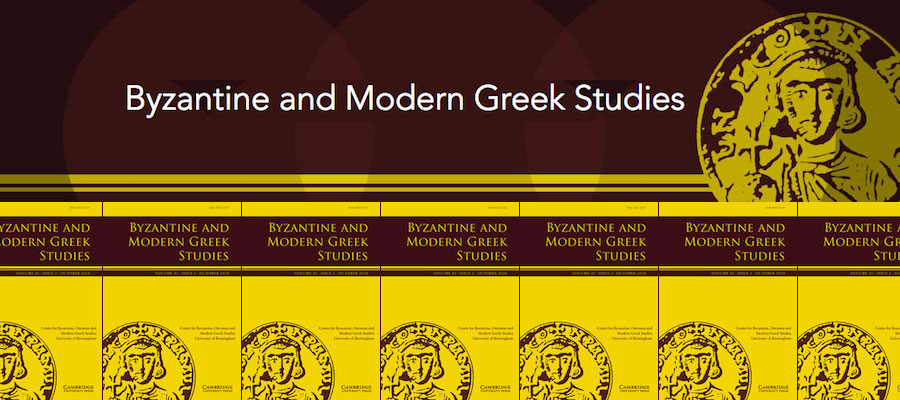Byzantine and Modern Greek Studies, volume 47, issue 1 (April 2023).
CONTENTS INCLUDE
Constructing the ‘theatre of power’: the performance of speeches of Emperor Leo VI the Wise
Cao Gu
Emperor Leo VI the Wise made speeches on various occasions, and the surviving texts have attracted numerous philological and historical studies. However, delivering a speech was never merely a monologue, especially in the court milieu where life was highly ritualized. It combined text-reading and multiple ceremonies and thus became a theatrical performance. In this ‘theatre’, the emperor's elegant appearance, the audience reaction to the orator's words following a set of conventions, and the venue decorated with torches, candles, and many other objects all played an indispensable role.
Tuning the pen: poetry writing and patronage networks around the end of the Byzantine empire
Krystina Kubina
The Ottoman conquest of Constantinople not only destroyed the Byzantine Empire as a political entity but caused the collapse of patronage networks vital to all aspects of Byzantine cultural life, including literary production. After 1453 authors had to seek sources of support under new lords and divergent cultural imperatives: Ottoman Constantinople, Crete, and humanist Italy became major centres of Greek poetic production and intellectual life. Through the analysis of poems by George Amiroutzes, Michael Apostoles, Bessarion, Andronikos Kallistos, and others, this article examines how these authors adapted their compositions to new communities, substantially transforming their (literary) identity.
Inter-faith relations and their spatial representation in the Late Medieval Aegean: the double-apsed churches of Kythnos in the Western Cyclades
Christianna Veloudaki
This article discusses the double-apsed churches (single-naved churches with two high altars) of Kythnos in the western Cyclades. The reasons for this uncommon configuration, although much debated, are not entirely clear. According to local tradition, during the period of Latin rule (thirteenth–seventeenth centuries) double-apsed churches were designed to accommodate both Orthodox and Catholic liturgies, or even some combination of the two. Combining information from written sources with architectural surveys at Oria Kastro, the island's ruined medieval capital, an attempt is made here to document Kythnos’ double-apsed churches and identify how these small provincial monuments reflect socio-religious conditions and inter-faith relations in the late medieval Aegean.
The Presence of Christ in the Eucharist κατ' οὐσίαν. On the interpretation and the source of a fragment from the Homily of George Scholarios and its impact on the Eucharistic doctrine of the Greek Orthodox Church
Mikhail Bernatsky
The Homily On the mystical body of our Lord Jesus Christ by George Gennadios II — Scholarios (ca. 1400 — paulo post 1472) was the first original Orthodox theological text to use the word μετουσίωσις (transubstantiatio) as an ex professo Eucharistic term and to adopt the doctrine associated with it. In this paper I propose a new reading of the fragment, in which Scholarios writes that God communicates with the faithful in the Eucharist by substance (κατ’ οὐσίαν). I argue that this fragment was a paraphrase of the third paragraph of chapter 61, book four of Thomas Aquinas’ Summa contra gentiles and should not be interpreted in the context of Palamite theology as has been proposed hitherto. I find support for my case in the manuscript Taurinensis XXIII (C-II-16), a compilation encouraged by Scholarios in 1432 and which contained the translation of the Summa contra gentiles by Demetrios Kydones. In addition, I outline the post Scholarium history of the expression κατ’οὐσίαν (secundum substantiam), which played a key role for the later development of the Eucharistic doctrine of the Orthodox Church in the post-Byzantine period.
Making sense of an execution: Patriarch Gregory V between the Sublime Porte and the Patriarchate
Yusuf Ziya Karabıçak
This article examines the events leading to the execution of Gregory V, Patriarch of Constantinople, utilizing accounts and documents in Ottoman Turkish and Greek. Gregory was the occupant of a post which involved striking a balance between different Phanariot factions, pro- and anti-Enlightenment tendencies, and localist and imperial expectations. This article argues that it was the outbreak of the Revolution in the Morea, rather than Ypsilantis’ movement, that upset the status quo, convincing the Ottoman elite that Gregory was no longer useful for the smooth functioning of Ottoman governance.
The popular perception of Byzantium in contemporary Turkish culture
Koray Durak
The aim of this article is to present the sources available to the ordinary Turkish citizen for forming an opinion about Byzantium. These sources range from the written (school curricula to newspapers) to the visual (cinema to television), and I categorize them on the basis of a set of criteria such as accessibility, control over the audience, and intellectual depth. I aim to show how non-state actors have been laying the groundwork for a more informed perception of Byzantium. Movies, theatrical productions, and cartoons in humorous magazines satirizing the essentializing view of the Byzantine past through parody, are shown to play a deconstructive role in this process.
Reviews
Alexander Riehle (ed.), A Companion to Byzantine Epistolography (Brill's Companions to the Byzantine World 7). Leiden–Boston: Brill, 2020. Pp. xii, 531.
Marc Lauxtermann
Buket Kitapçı Bayrı, Warriors, Martyrs, and Dervishes – moving frontiers, shifting identities in the land of Rome (13th-15th centuries). Leiden and Boston: Brill, 2020. Pp. xii, 259.
Myrto Veikou
